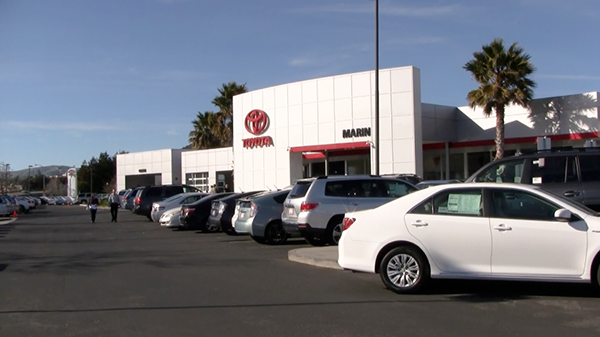
The first lessons of car ownership happen at the dealership. Photo: Toyota Marin (2017)
What’s the perfect accessory to go with a cap and gown? A set of car keys. With graduation season upon us, many young people will be getting their first cars before heading off to college or starting their first jobs. A car allows a young person to experience freedom and independence, but it’s also a serious responsibility. School may be over for your child, but the life lessons are just about to begin. To learn how you can help teach your child to be a responsible car owner, read these tips provided by five Diamond Certified Experts.
How to buy a car
For many young people, an auto dealership may be where the car of their dreams crashes into the reality of their bank accounts. Even if the car is a gift, it’s a good idea to include your child in the purchasing process. Parents can help their kids by offering advice on how to establish a monthly budget for car payments and auto insurance. Walk your child through the process of learning a used car’s safety history and introduce them to online resources that help determine fair price points.
Auto maintenance basics
Experienced car owners know vehicles need more than just gas and an occasional wash. Draw up a calendar with your child that details the maintenance they should expect over the next 12 months, three years and five years. Make sure to touch upon the following:
Oil changes
Unless your child purchases an electric vehicle, their car will require motor oil to keep the moving parts of the engine lubricated, which reduces wear and corrosion. A new car owner should know how to check the oil levels, how frequently the oil needs to be changed and what kind of motor oil their model of car requires. Most auto professionals agree that it’s unwise to wait until the “check oil” light illuminates—by then, engine corrosion may have already occurred.
Tires
Properly inflated tires are an essential aspect of driver safety. Make sure your recent grad knows how to use a tire pressure gauge and can inflate or deflate tires as needed. Your child should also know how to remove a flat tire and attach a spare. Explain how to look for signs of wear and tear and teach them how to determine when it’s time for new tires. Not only will properly maintained tires improve safety, they’ll also improve the car’s fuel efficiency. To learn more, see Diamond Certified Expert Josh Cherry’s tip for maximizing vehicle performance with proper tire pressure.
Brakes
Most new cars have brake pad sensors that indicate when they’re getting worn down, but if your child is purchasing an older vehicle, make sure they know how to tell when the brakes need to be repaired or replaced. A visual inspection is important for determining if brakes are approaching the end of their lifespan. Diamond Certified Expert Cliff Do explains how to do this in further detail.
Car accidents
Most car accidents are minor, but it’s still important for your child to know what steps to take after a collision occurs and you’re not there. For once, be thankful that your kids always seem to have their smartphones nearby. After they’ve determined everyone is OK, your child should use their phone to collect contact and insurance information from the other driver, take pictures of the damage, and note license plate numbers. Your child should also save the phone numbers for their insurance company and local tow companies so they can easily contact them after a collision. Our resource page on car accidents provides more in-depth information for Bay Area drivers.
Prepare for emergencies
As a parent, it can be nerve-wracking to see your kid drive off on their own for the first time. Rest a little easier by preparing a vehicle emergency kit with your child. The kit should contain first aid items (bandages, tweezers, medical tape), car repair items (tire jack, jumper cables) and safety items (flashlight, poncho, blinking lights).
Young drivers can be over-reliant upon cellphones, but what happens if there’s an emergency and their phone’s battery is dead or they’re located out of range? Make sure your child’s car is well-supplied with quarters (for payphones) and keep a list of important phone numbers in their glove compartment.
Time to drive off into the sunset…
Most young people will have some bumps and jolts along the way as they care for their first cars, but it’s also an opportunity for them to demonstrate their capacity for adult responsibilities. For parents, a child’s first car may be a time to feel nostalgic or worried, but hopefully, it’s also a time when they realize their kid has been listening after all.
